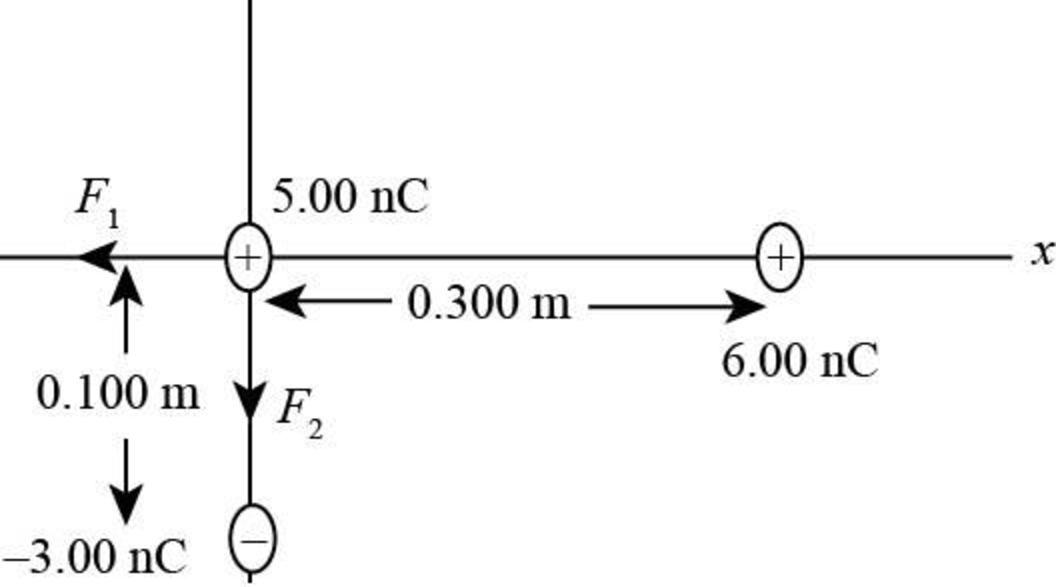
Concept explainers
(a)
The vector electric field created by the
(a)
Answer to Problem 35P
The vector electric field that the
Explanation of Solution
The following figure represents the forces acting on the charges.

Figure-(1)
Here,
Write the expression for the electric field at origin by the charge
Here,
Write the constant value for the Coulomb constant
Write the expression for the electric field at origin by the charge
Here,
Write the expression for the total vector electric field at origin by the charges
Here, the
Write the expression to convert the units for charge
Write the expression to convert the units for charge
Substitute
Conclusion:
Convert the units for the charge
Convert the units for the charge
Substitute
Further simplify the above equation.
Therefore, the vector electric field that the
(b)
The vector force on the
(b)
Answer to Problem 35P
The vector force on the
Explanation of Solution
Write the expression for the relation between the electric force and the electric field.
Here,
Write the expression to convert the units for charge
Conclusion:
Convert the units for the charge
Substitute
Therefore, the vector force on the
Want to see more full solutions like this?
Chapter 23 Solutions
Physics: for Science.. With Modern. -Update (Looseleaf)
- In Figure P24.49, a charged particle of mass m = 4.00 g and charge q = 0.250 C is suspended in static equilibrium at the end of an insulating thread that hangs from a very long, charged, thin rod. The thread is 12.0 cm long and makes an angle of 35.0 with the vertical. Determine the linear charge density of the rod. FIGURE P24.49arrow_forwardEight small conducting spheres with identical charge q = 2.00 C are placed at the corners of a cube of side d = 0.500 m (Fig. P23.75). What is the total force on the sphere at the origin (sphere A) due to the other seven spheres? Figure P23.75arrow_forwardA Figure P23.65 shows two identical conducting spheres, each with charge q, suspended from light strings of length L. If the equilibrium angle the strings make with the vertical is , what is the mass m of the spheres? Figure P23.65arrow_forward
- A line of positive charge is formed into a semicircle of radius R = 60.0 cm as shown in Figure P23.41. The charge per unit length along the semicircle is given by the expression = 0 cos . The total charge on the semicircle is 12.0 C. Calculate the total total on a charge of 3.00 C placed at the center of curvature P. Figure P23.41arrow_forwardA conducting rod carrying a total charge of +9.00 C is bent into a semicircle of radius R = 33.0 cm, with its center of curvature at the origin (Fig.P24.75). The charge density along the rod is given by = 0 sin , where is measured clockwise from the +x axis. What is the magnitude of the electric force on a 1.00-C charged particle placed at the origin?arrow_forwardThree particles with charges of 1.0 C, 1.0 C, and 0.50 C are placed at the corners A, B, and C of an equilateral triangle with side length 0.10 m as shown in Figure P23.72. Find the net force on the charge at point C.arrow_forward
- Given the arrangement of charged particles shown in Figure P23.37, find the net electrostatic force on the 5.00-nC charged particle located at the origin. Figure P23.37arrow_forwardA uniformly charged rod of length L and total charge Q lies along the x axis as shown in Figure P23.6. (a) Find the components of the electric field at the point P on the y axis a distance d from the origin. (b) What are the approximate values of the field components when d L? Explain why you would expect these results. Figure P23.6arrow_forwardThree small metallic spheres with identical mass m and identical charge +q are suspended by light strings from the same point (Fig. P23.55). The left-hand and right-hand strings have length L and make an angle with the vertical. What is the value of q in terms of k, g, m, L, and ? Figure P23.55arrow_forward
- A uniform electric field given by E=(2.655.35j)105N/C permeates a region of space in which a small negatively charged sphere of mass 1.30 g is suspended by a light cord (Fig. P24.53). The sphere is found to be in equilibrium when the string makes an angle = 23.0. a. What is the charge on the sphere? b. What is the magnitude of the tension in the cord? FIGURE P24.53arrow_forwardA uniformly charged insulating rod of length 14.0 cm is bent into the shape of a semicircle as shown in Figure P23.45. The rod has a total charge of 7.50 C. Find (a) the magnitude and (b) the direction of the electric field at O, the center of the semicircle.arrow_forwardA metal sphere with charge +8.00 nC is attached to the left-hand end of a nonconducting rod of length L = 2.00 m. A second sphere with charge +2.00 nC is fixed to the right-hand end of the rod (Fig. P23.53). At what position d along the rod can a charged bead be placed for the bead to be in equilibrium? FIGURE P23.53arrow_forward
 Physics for Scientists and Engineers with Modern ...PhysicsISBN:9781337553292Author:Raymond A. Serway, John W. JewettPublisher:Cengage Learning
Physics for Scientists and Engineers with Modern ...PhysicsISBN:9781337553292Author:Raymond A. Serway, John W. JewettPublisher:Cengage Learning Physics for Scientists and Engineers: Foundations...PhysicsISBN:9781133939146Author:Katz, Debora M.Publisher:Cengage Learning
Physics for Scientists and Engineers: Foundations...PhysicsISBN:9781133939146Author:Katz, Debora M.Publisher:Cengage Learning Physics for Scientists and EngineersPhysicsISBN:9781337553278Author:Raymond A. Serway, John W. JewettPublisher:Cengage Learning
Physics for Scientists and EngineersPhysicsISBN:9781337553278Author:Raymond A. Serway, John W. JewettPublisher:Cengage Learning Physics for Scientists and Engineers, Technology ...PhysicsISBN:9781305116399Author:Raymond A. Serway, John W. JewettPublisher:Cengage Learning
Physics for Scientists and Engineers, Technology ...PhysicsISBN:9781305116399Author:Raymond A. Serway, John W. JewettPublisher:Cengage Learning



